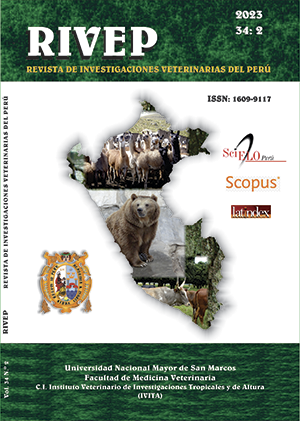Artificial intelligence adaptation by the stochastic multiple regression model to determine the fibre quality of alpaca (Lama pacos)
DOI:
https://doi.org/10.15381/rivep.v34i2.23130Keywords:
alpaca fiber, artificial intelligence, Soft factor, stochastic multiple regressionAbstract
The application of artificial intelligence based on the multiple linear regression model with stochastic descending gradient is described in order to determine the quality of the white Huacaya alpaca fibre. In total, 1200 fibres corresponding to six alpaca samples were analysed. The fibres were characterized by optical microscopy and with the optical fibre diameter analyser (OFDA 100) equipment. Fibre diameter, medulla diameter, percentage of medullation by volume, comfort factor, and objectionable fibres were considered as independent variables, and the “Soft” factor was considered as a response variable. This last variable resulting from the difference in the comfort factor and objectionable fibres served to give a logical order to the data matrix and obtain an accurate prediction model. The average values were 26.80 ± 6.95 for the fibre diameter, 14.10 ± 5.92 for the medulla diameter, 24.75 ± 13.20 µm for the percentage of medullation by volume and 71.56 ± 13.04% for the comfort factor. The machine learning multiple linear regression modelling fitted a small sample size with high precision, showing minimal errors, and optimized with the stochastic gradient descent algorithm predicted a Soft factor very close to the observed Soft factor. It is concluded that the multiple linear regression technique with the stochastic approach satisfies the prediction of the new factor called "soft" and that it represents the appropriate modelling for the prediction of fibre quality in the textile industry.
Downloads
Downloads
Published
Issue
Section
License
Copyright (c) 2023 Abdel Alejandro Portocarrero Banda, Erik Vilca Cayllahua, Briguit Stefany Ortiz Quispe, Lilia Mary Miranda Ramos, Hugo Guillermo Jiménez Pacheco

This work is licensed under a Creative Commons Attribution 4.0 International License.
AUTHORS RETAIN THEIR RIGHTS:
a. Authors retain their trade mark rights and patent, and also on any process or procedure described in the article.
b. Authors retain their right to share, copy, distribute, perform and publicly communicate their article (eg, to place their article in an institutional repository or publish it in a book), with an acknowledgment of its initial publication in the Revista de Investigaciones Veterinarias del Perú (RIVEP).
c. Authors retain theirs right to make a subsequent publication of their work, to use the article or any part thereof (eg a compilation of his papers, lecture notes, thesis, or a book), always indicating the source of publication (the originator of the work, journal, volume, number and date).



